It’s Tuesday, so you know what that means!
Time for a brand new Tuesday Debut!
It’s so much fun to meet new authors, isn’t it? And see the wonderful books they’ve created? And hear about how they got from writing and hoping to PUBLISHED! 😊
I also love the opportunity to learn about the creative process involved for all different kinds of books. We’ve have authors, and illustrators, and author/illustrators, fiction and nonfiction, religious, dyslexia-friendly, self-published. . . and today, we’ve got a debut book that is “illustrated” with photographs! Something new for us to educate ourselves about!
So without further ado, I’m delighted to present today’s Tuesday Debut-ess, Cynthia Argentine, and her gorgeous book, NIGHT BECOMES DAY: CHANGES IN NATURE!
Night Becomes Day: Changes in Nature
written by Cynthia Argentine
no illustrator (illustrated with photographs)
Millbrook Press, a division of Lerner Publishing Group
10/5/2021
Nonfiction
ages 4-9
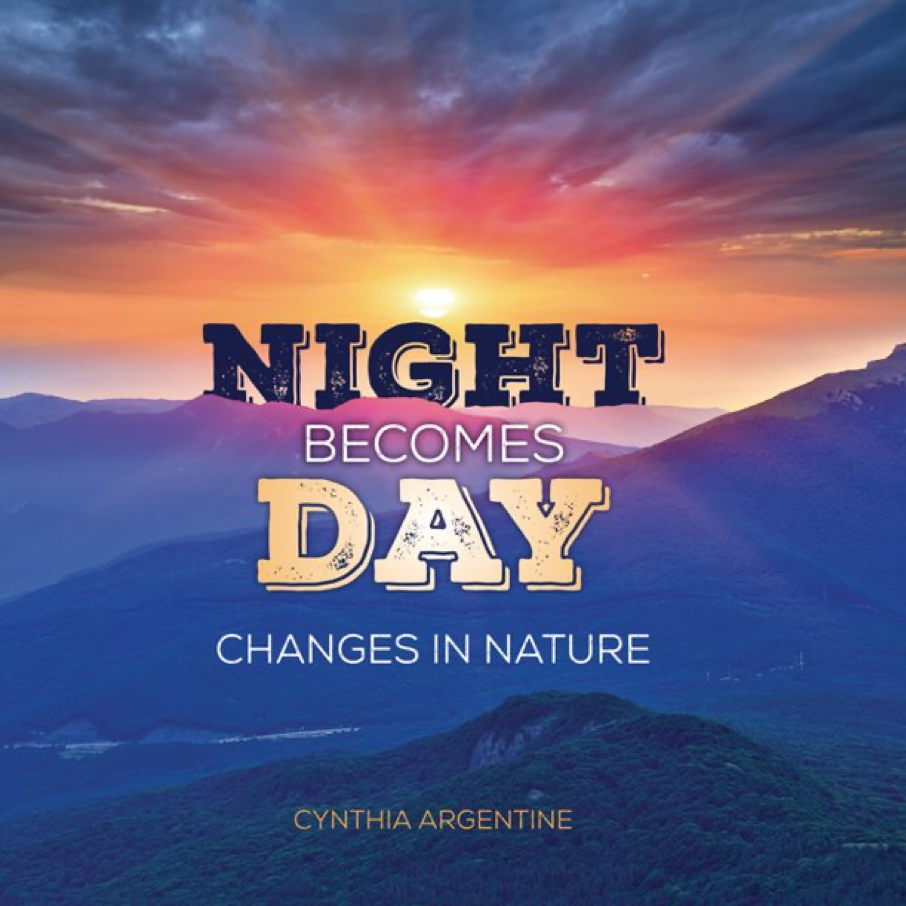
Whether sudden or gradual, change is a constant in our world. NIGHT BECOMES DAY shows the beauty and power of nature through transformations happening all around us. Pairing lyrical text with vivid photos, the book takes readers from beaches and woods to caves, canyons, glaciers, and more.
SUSANNA: Welcome, Cynthia! We are thrilled to have you here today, and so excited to learn about your journey to publication! Where did the idea for this book come from?
CYNTHIA: Thanks so much for having me, Susanna!
Three specific things came together to inspire this book:
- spring outside my window
- a class called Nonfiction Archaeology, and
- broccoli. (I’ll explain!)
It was March of 2017, and I was taking an online class called Nonfiction Archaeology led by Kristen Fulton. One assignment was to come up with an idea for a science-based, nonfiction picture book. Noticing the spring transformations happening right outside my window, I started listing them. I thought about how familiar some changes were and how surprising others could be. The first time I grew broccoli, for example, I discovered—lo and behold!—it could turn into a bouquet of yellow blossoms. I realized children might be interested in learning about all sorts of transformations as well.
SUSANNA: How long did it take you to write this book?
CYNTHIA: Digging up the answer to this question was enlightening! I went back through old computer files, and my first document related to this project was dated March 20, 2017 and titled “Nature Changing Cycling Surprising Picture Book Compass.” I was clearly just brainstorming at that point! But in that document, I worked out my central nugget and theme. Key phrases included “nature is constantly changing” and “this view of nature brings awe, wonder, beauty, and interconnectedness to our world.” Those statements guided my writing from initial idea to publication.
As for the actual timing…. I looked back at my file history and discovered this:
- I spent ten hours, spread over three evenings, writing my first draft, which is strikingly similar to the published text.
- Before starting that first draft, I spent five days pre-writing. This included jotting down ideas. Tapping into childhood memories. Categorizing changes by scientific discipline. Playing with pairs of opposites. Reading other nonfiction mentor texts. Developing a satisfying beginning, middle, and end. Organizing an outline. And mocking up a 32-page dummy.
SUSANNA: Wow! Not only are you way more organized than I am in your pre-writing, you know how many days and hours you spent! What amazing record-keeping! Did you go through many revisions?
CYNTHIA: Yes! I revised the initial manuscript off and on for about a year, putting it away for days or weeks at a time. During that period, I also did a lot of research to support and expand the scientific aspects of the book. Some of that research became part of the back matter.
My wonderful critique partners played a part in the revision process, too. We read each other’s work individually and then meet to discuss it. This helps me identify both the strong and weak points in a manuscript.
SUSANNA: When did you know your manuscript was ready for submission?
CYNTHIA: When I faced a deadline! 😉 There is nothing like a deadline for motivation. The deadline for this submission came in the form of a blog post written by Carol Hinz at Millbrook Press (a division of Lerner Publishing). I knew that Lerner published the kinds of books I was interested in writing, so I had already subscribed to their blog. In March of 2018, the blog post advertised a call for nonfiction manuscripts for grades K-3 that could be illustrated with photographs. (Learn more about that here.) I had read and admired several books published by Millbrook and edited by Hinz, so I was excited to have an opportunity to submit to them.
SUSANNA: When and how did you submit?
CYNTHIA: On April 30, 2018, I emailed Lerner my manuscript. I don’t have an agent, so I recognized this as an important opportunity. I had developed a list of other houses that accepted nonfiction from un-agented authors, but I never submitted this manuscript elsewhere.
SUSANNA: How long after you submitted were you told it was a “yes”?
CYNTHIA: In August, four months after my submission, I got an email from Carol Hinz saying it was “a strong manuscript” and she’d like some more time to consider it. Four months after that, in December, Carol said yes—she wanted to take it to acquisitions! YAY! That was a wonderful Christmas present.
SUSANNA: When did you get “the call”, which these days is more likely to be “the email”? (Best moment ever! 😊)
CYNTHIA: Less than a month later, on January 11, 2019, Carol emailed to say that Lerner wanted to acquire it! Happy New Year!
SUSANNA: How long was it between getting your offer and getting your contract to sign?
CYNTHIA: Less than two months. Lerner and I both signed shortly after that. The contracts department at Lerner was helpful and friendly.
SUSANNA: How did you celebrate signing your contract?
CYNTHIA: I strongly believe in celebrating milestones, but I honestly don’t remember whether I did anything special to commemorate signing. I do remember the night I got the “yes” from acquisitions. I ran downstairs, told everyone in my family, and had extra ice cream for dessert!
SUSANNA: Was the contract what you expected in terms of advance, royalty percentage, publication timeline, author copies etc.?
CYNTHIA: I was working on a middle-grade, work-for-hire book around this same time, and I will say that my payment for that book and the advance on this book were in the same ballpark. Lerner isn’t a big-five house, and I was a first-time author with them, so the advance wasn’t large. Nonetheless, there were benefits. I felt it was a great place for this manuscript, and I was excited to work with Carol Hinz based on the excellence of the other K-3 photo nonfiction Millbrook Press had recently produced. I was able to negotiate for an escalation clause on royalties and for additional author copies (25).
SUSANNA: Can you tell us a little about the editorial process?
CYNTHIA: The book was slated for publication two years out (2021), so we didn’t begin the editorial process right away. In February of 2020, a member of the editorial staff contacted me and recommended a few minor line edits. Then that editor left, and the pandemic spread, and we learned that Lerner was pushing back publication from Spring to Fall 2021.
The editorial process resumed in earnest in December of 2020. Carol Hinz completely understood my vision for the book, and it was great to work with her on it. She had ideas for strengthening the manuscript and particularly encouraged me to carefully consider the opposite pairs. (The book is structured around opposite types of change.) We also exchanged many emails about details in the back matter, making sure the science was as clear and accurate as possible. Her editorial work definitely improved the book.
SUSANNA: What was your experience of the illustration process like?
CYNTHIA: One of the interesting things about this project is that it is illustrated with photographs. I did not envision it that way when I wrote it—I pictured drawings and paintings. But when Lerner’s open call requested books that could be photo-illustrated, I realized mine had that potential. In the end, it worked out beautifully! The vibrancy of the photos invites readers to take a closer look.
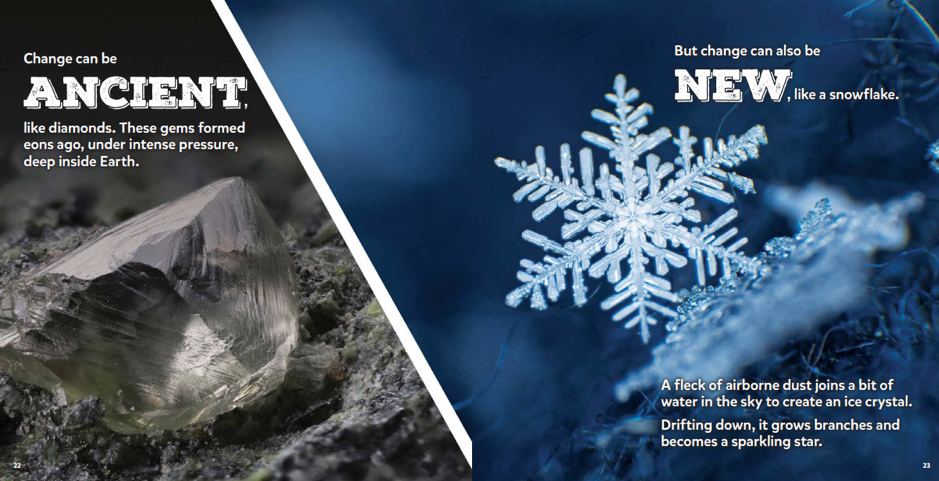
Lerner’s art department handled the photo selection and permissions. Mary Ross at Lerner did the design. In most cases, the initial photos they selected were exactly what I was describing. The beaches, caves, glaciers, and mountains were stunning! In a couple cases, the initial photo choices had to be adjusted. For example, I wanted a photo to show an additional stage in the transformation from flower to fruit. They added one to accomplish that. In another case, they could not find a photo to exactly match what I had described in the text, so I revised the text to match the photo they suggested. It was definitely a collaborative process, and I’m grateful for that.
SUSANNA: Did you get to see advance reviews from Kirkus, SLJ, etc? What was that like?
CYNTHIA: One has come in so far! Kirkus praised the book, saying it
- “leads readers to notice and seek out the many changes that are taking place in their world,”
- “simultaneously folds in a lesson in opposites,” and
- “will hold readers’ interest.”
Lerner put an advance digital copy on NetGalley.com as well. It received great reviews from teachers, parents, and librarians there. It’s so rewarding to see the book connect with and inspire readers. Thank you, advance reviewers!
SUSANNA: How long did it take from offer to having the first copy in your hand?
CYNTHIA: My author copies should be arriving any day! It will have been two years and eight months.
SUSANNA: What kind of marketing and promotion has your publisher done for this book?
CYNTHIA: In addition to submitting the book to major review journals and putting it on NetGalley.com, Lerner mailed hard copies to several media outlets. They helped me make a promo video of the book and posted it online here. They are actively promoting the book on social media and their website as well. And they sent me a packet a few months ago with information about what I could do.
SUSANNA: Describe any marketing/promotion you did for this book.
CYNTHIA: There has been so much to learn in this area! I have lined up several local in-person events, including a book-birthday bash with my local library and our nature center. My town is featuring Night Becomes Day in its StoryWalk installation during the month of October. And I’m doing a virtual book launch with SK Wenger through The Writing Barn in Austin, Texas on October 9. (It’s free! Come join us!)
I’m also part of two co-marking groups—21forthebooks and STEAMTeam2021—both of which have been so valuable. I highly recommend having partners to help you climb the learning curve! I made bookmarks and stickers using Canva and Vistaprint online. I partnered with Deb Gonzales to build Pinterest pins and a teacher’s guide related to my book. And I’m appearing on several blogs in October in addition to this one. I also have prepared presentations with ties to my book. In August, I gave a webinar called “Science—An Open Door to Creativity” for the Montessori Family Alliance. In November, I’m presenting a webinar called “Nonfiction: A Vast, Vibrant Genre from Board Books to Middle Grade.” It’s hosted by Indiana SCBWI and you can learn more here!
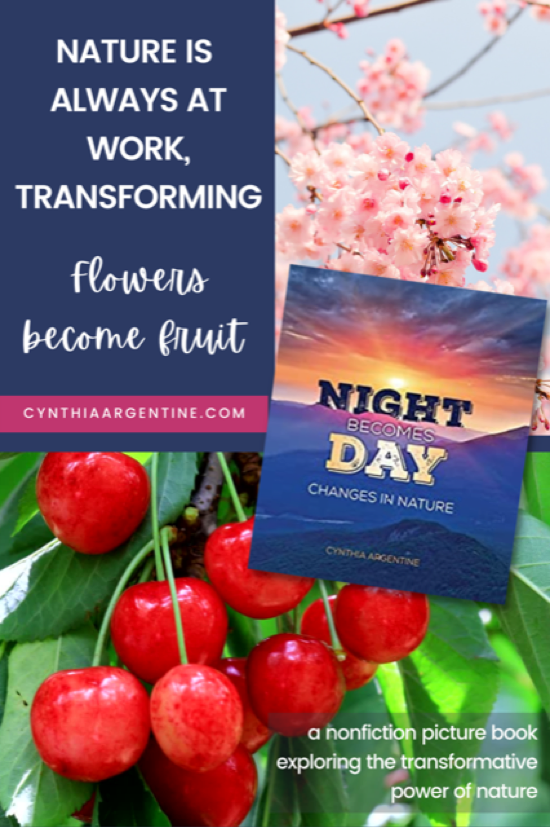
SUSANNA: How long was it between the time you started writing seriously and the time you sold your first picture book?
CYNTHIA: I started writing for children in 2007 with a course through the Institute for Children’s Literature. I discovered I loved writing nonfiction articles and began regularly contributing to children’s magazines such as Odyssey: Adventures in Science and ChemMatters. Then, in 2016, I found a subject that deserved more than an article. This woman needed to be the focus of a picture book biography. At that point, I shifted my energy into learning how to write picture books, which are very different from magazine articles. So, if I count back to that point in 2016, it took three years. If I count back to that first course in 2007, it took twelve years.
SUSANNA: What is the most important/helpful thing you learned on your way to publication? (Or what is your most helpful piece of advice for up and coming writers?)
CYNTHIA: For most of us, writing is a calling. It’s something we do despite the fact that some stories may never sell and our books may not yield significant financial gain. We do it because we have felt something in this world that moved us, and we want to share that experience and emotion with someone else. We see that writing forges connections—connections between us and our subjects, between us and our critique partners, between us and our readers.
Writing for children is an art form. Like all art, it has the capacity to be beautiful, resonant, and unique. Good books for children develop through the accumulated insights of years. Invest the time, and recognize that creating books is a worthy calling.
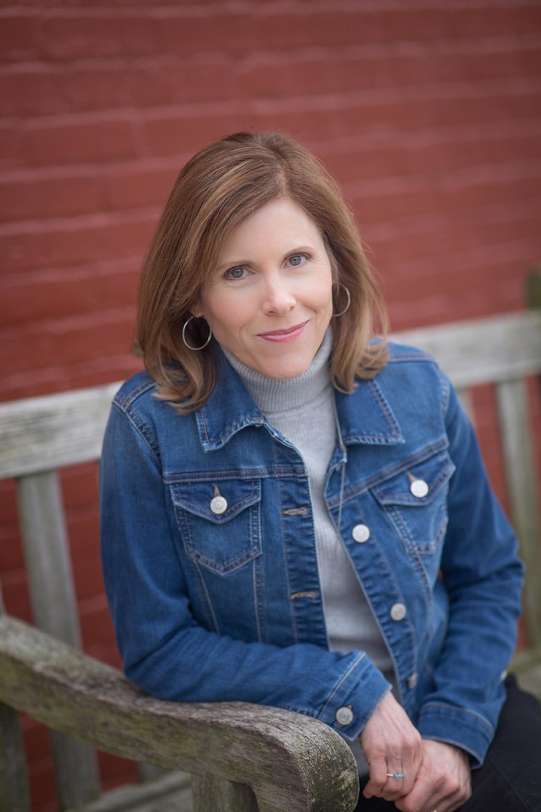
Website
Pinterest @CynthiaArgentine
Twitter @CindyArgentine
Instagram @argentine_writer
SUSANNA: Thank you so much for taking the time to participate in this series and paying it forward to other writers, Cynthia! We so appreciate the opportunity to learn from your experience, and wish you all the very best with this and future titles!
Readers, if you have questions for Cynthia, please post them in the comments below and if she has time I’m sure she’ll respond!
You may purchase Cynthia’s book at:
(all links below are book-specific)
We can help our debut authors successfully launch their careers by:
– purchasing their books
– recommending their books to friends and family
– recommending their books to our children’s teachers and librarians
– recommending their books to our local libraries and bookstores
– suggesting them as visiting authors at our children’s schools and our local libraries
– sharing their books on social media
– reviewing their books on Goodreads, Amazon, Barnes&Noble, and other sites where people go to learn about books.
Thank you all for stopping by to read today! Have a lovely, inspiration-filled Tuesday! Maybe today is the day you’ll write your debut picture book 😊
Missed any previous Tuesday Debuts? Check them out!
Christy Mihaly – Hey! Hey! Hay! A Tale of Bales And The Machines That Make Them
Jessie Oliveros – The Remember Balloons
Beth Anderson – An Inconvenient Alphabet: Ben Franklin And Noah Webster’s Spelling Revolution
Hannah Holt – The Diamond And The Boy
Laura Renauld – Porcupine’s Pie
Annie Romano – Before You Sleep: A Bedtime Book Of Gratitude
Melissa Stoller – Scarlet’s Magic Paintbrush
Sherry Howard – Rock And Roll Woods
Kate Narita – 100 Bugs! A Counting Book
Vivian Kirkfield – Pippa’s Passover Plate
Laura Roettiger – Aliana Reaches For The Moon
Matthew Lasley – Pedro’s Pan: A Gold Rush Story
Natalee Creech – When Day Is Done
Margaret Chiu Greanias – Maximillian Villainous
Wendy Greenley – Lola Shapes The Sky
Danielle Dufayet – You Are Your Strong
B.J. Lee – There Was An Old Gator Who Swallowed A Moth
Cathy Ballou Mealey – When A Tree Grows
Pippa Chorley – Counting Sheep
Sandra Sutter – The Real Farmer In The Dell
Jill Mangel Weisfeld – Riley The Retriever Wants A New Job (self pub)
Kathleen Cornell Berman – The Birth Of Cool: How Jazz Great Miles Davis Found His Sound
Eleanor Ann Peterson – Jurassic Rat
Sarah Hoppe – Who Will? Will You?
Marla LeSage – Pirate Year Round
Stacey Corrigan – The Pencil Eater
Shannon Stocker – Can U Save The Day?
Nadine Poper – Randall And Randall
Christine Evans – Evelyn The Adventurous Entomologist
Karen Kiefer – Drawing God (religious market)
Dawn Young – The Night Baafore Christmas
Heather Gale – Ho’onani: Hula Warrior
Ciara O’Neal – Flamingo Hugs Aren’t For Everyone (self pub)
Theresa Kiser – A Little Catholic’s Book Of Liturgical Colors (religious market)
Lindsey Hobson – Blossom’s Wish (self pub)
Kirsten Larson – Wood, Wire, Wings: Emma Lilian Todd Invents An Airplane
Valerie Bolling – Let’s Dance!
Janet Johnson – Help Wanted: Must Love Books
Heather Kinser – Small Matters: The Hidden Power of the Unseen
Kelly Carey – How Long Is Forever?
Mary Wagley Copp – Wherever I Go
Nell Cross Beckerman – Down Under The Pier
Claire Noland – Evie’s Field Day: More Than One Way To Win
Sharon Giltrow – Bedtime, Daddy!
Gabi Snyder – Two Dogs On A Trike
Lisa Katzenberger – National Regular Average Ordinary Day
Teresa Krager – Before Your Birth Day
Lindsay H. Metcalf – Beatrix Potter, Scientist
Nancy Roe Pimm – Fly, Girl, Fly! Shaesta Waiz Soars Around The World
Jolene Gutiérrez – Mac And Cheese And The Personal Space Invader
Julie Rowan-Zoch – Louis (picture book illustration debut!)
Janie Emaus – Latkes For Santa
Amy Mucha – A Girl’s Bill Of Rights
Melanie Ellsworth – Hip,Hip…Beret!
Rebecca Kraft Rector – Squish Squash Squished
Gnome Road Publishing (publishing house debut)
Sue Heavenrich – 13 Ways To Eat A Fly
Julie Rowan-Zoch – I’m A Hare So There (author/illustrator debut)
Nancy Derey Riley – Curiosity’s Discovery (author/illustrator self-published debut)
Moni Ritchie Hadley – The Star Festival
Sita Singh – Birds Of A Feather
Ann Magee – Branches Of Hope: The 9/11 Survivor Tree
Amanda Davis – 30,000 Stitches: The Inspiring Story of the National 9/11 Flag (nonfiction)
Jennifer Buchet – Little Medusa’s Hair Do-lemma
Michelle Vattula – The Stalking Seagulls
Christine Van Zandt – A Brief History Of Underpants (nonfiction)
Candice Marley Conner – Sassafras And Her Teeny Tiny Tail
Becky Scharnhorst – My School Stinks!
Darshana Khiani – How To Wear A Sari
Ana Siqueira – Bella’s Recipe For Success
Kate Allen Fox – Pando: A Living Wonder Of Trees (nonfiction)
Jenna Waldman – Sharkbot Shalom
Karen A. Wyle – You Can’t Kiss A Bubble
Rebecca Mullin – One Tomato (board book)
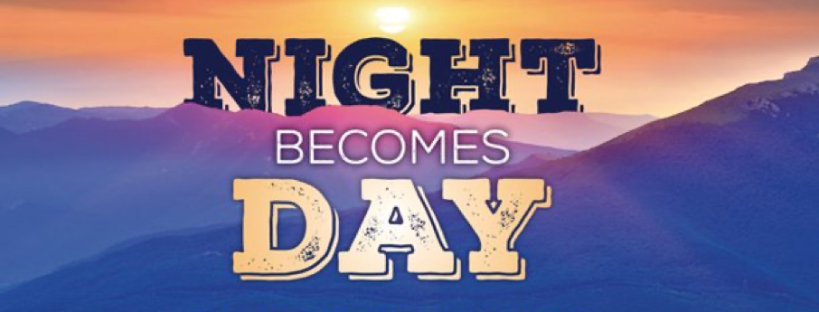












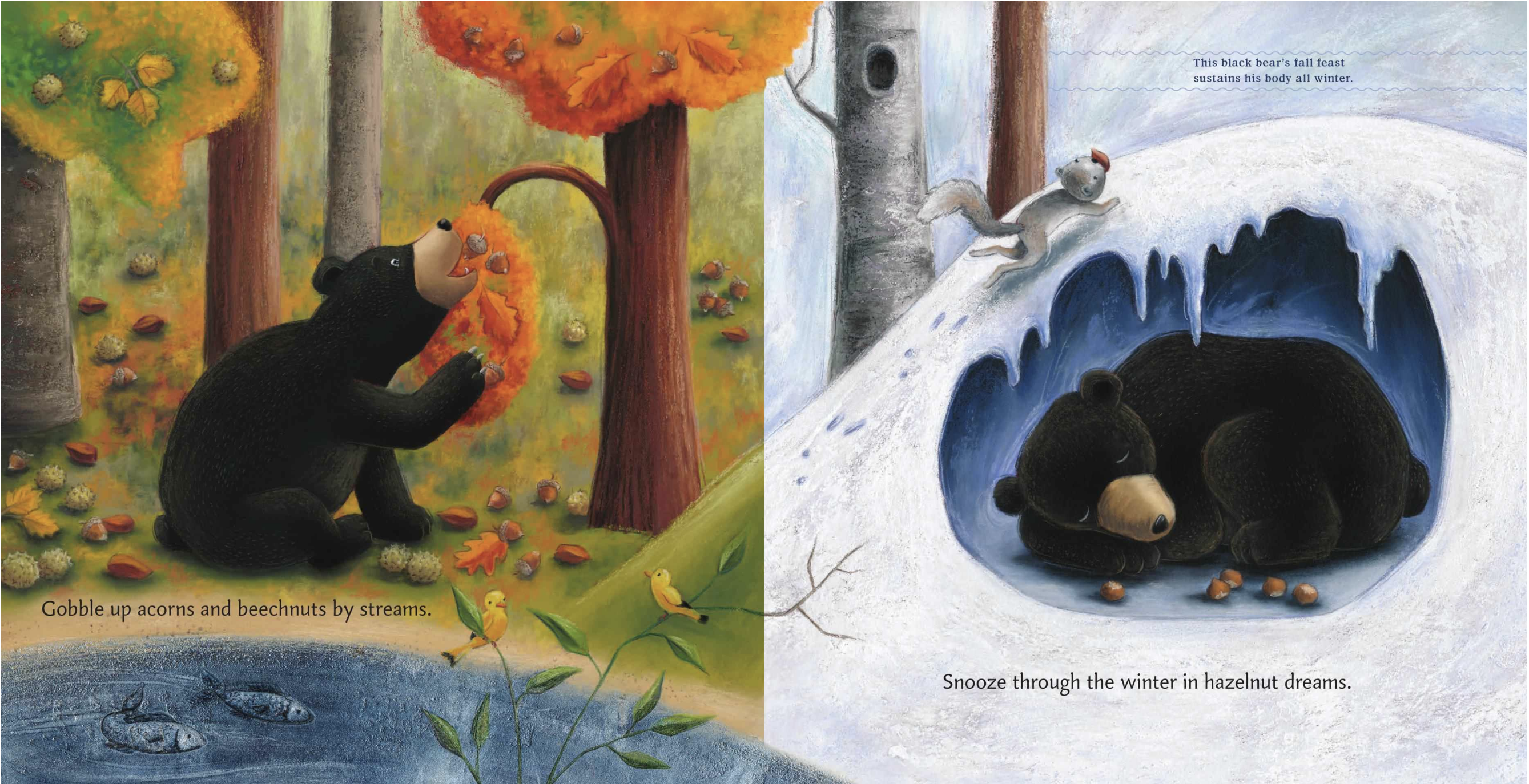



You must be logged in to post a comment.